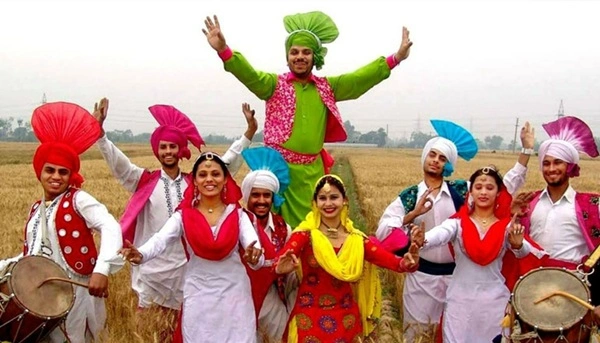Punjab, known as the “Land of Five Rivers,” is famous for its vivid cultural life, colorful festivals, and hearty celebrations. Punjabi culture is deeply tied to agriculture, religious traditions, and communal festivities. Its dances are energetic, joyful, and expressive, reflecting the vigorous spirit of the people.
From the high-spirited Bhangra, performed to celebrate harvest and prosperity, to the graceful Giddha, highlighting women’s stories and folk tales, the folk dances of Punjab capture the essence of Punjabi identity. These dances are not just entertainment—they are a medium of storytelling, community bonding, and cultural expression.
Major Traditional and Folk Dances of Punjab

| Dance | Type | Region | Short Description |
| Bhangra | Folk | Majha, Doaba, Malwa regions | High-energy dance traditionally performed during harvest festivals, symbolizing joy and prosperity. |
| Giddha | Folk | Across Punjab | Female folk dance expressing daily life, folk tales, and social stories with rhythmic claps and bhangra-style movements. |
| Jhumar / Ghumar | Folk | Sandal Bar, Malwa | Graceful, slow dance performed by men and women, often at weddings and harvest celebrations. |
| Luddi | Folk | Majha & Doaba | Circle dance performed in celebration, often involving swords, sticks, or shields. |
| Sammi | Folk | Sandal Bar & Malwa | Women’s dance with graceful steps and swaying movements, often performed at weddings and festivals. |
| Kikli | Folk | Across Punjab | A playful women’s dance performed in pairs by spinning in circles holding hands. |
| Dhamaal / Dhulla | Folk | Rural Punjab | Devotional dance performed in Sufi shrines and festivals, celebrating saints and spiritual ecstasy. |
| Malwai Giddha | Folk | Malwa region | Male version of Giddha with storytelling, satire, and traditional props like sticks. |
| Rouki / Rouki Dance | Folk | Rural Punjab | Agricultural dance depicting ploughing, sowing, and harvesting activities. |
| Chhajja / Fuggri | Folk | Patiala & Amritsar | Female dance performed during local fairs and seasonal festivals, often depicting harvest and social stories. |
Detailed Explanation of Major Dances
Bhangra – The Soulful Harvest Dance
- Origin: Developed in the Majha and Doaba regions of Punjab, traditionally performed by male farmers during the Baisakhi harvest festival.
- Cultural Significance: Symbolizes celebration, energy, and gratitude for a good harvest. Over time, it has become a global symbol of Punjabi culture.
- Costumes: Bright kurta, lungi or chaadra (dhoti-style cloth), turban (pagri), colorful waistcoat, and traditional jewelry for embellishments.
- Musical Instruments: Dhol, Chimta, Bugchu, Tumbi.
- Occasions: Baisakhi, weddings, cultural events, and modern stage performances.
- Image Suggestion: Men in colorful attire jumping with joy while playing dhols in fields.
Giddha – The Graceful Women’s Dance
- Origin: Traditionally performed by women during social gatherings and harvest festivals.
- Cultural Significance: Highlights women’s creativity, daily life, folklore, and humor through rhythmic movements and energetic clapping.
- Costumes: Salwar kameez with heavy embroidery, chunni (veil), bangles, and anklets.
- Musical Instruments: Dhol, Chimta, and folk singing (boliyan).
- Occasions: Festivals, weddings, harvest celebrations, and cultural programs.
- Image Suggestion: Women in colorful suits performing Giddha in open fields or courtyards.
Jhumar / Ghumar – The Slow Folk Dance
- Origin: Popular in Sandal Bar and Malwa regions, originally performed by men around harvest season.
- Cultural Significance: Expresses emotions of joy, love, and community bonding, often accompanied by folk songs.
- Costumes: Men wear kurta-pajama with turbans; women wear colorful suits.
- Musical Instruments: Dhol, Sarangi, Flute, and Manjira.
- Occasions: Weddings, fairs, and harvest festivals.
- Image Suggestion: Couples or groups performing slow rhythmic steps in circles.
Luddi – The Circle Dance of Celebration
- Origin: Performed in Majha and Doaba, often by groups during victories or joyful occasions.
- Cultural Significance: Celebratory dance that includes sword, stick, or shield movements to showcase bravery.
- Costumes: Kurta, pajama, turban for men; colorful suits for women when participating.
- Musical Instruments: Dhol, Chimta, and folk singing.
- Occasions: Weddings, sports victories, harvest celebrations.
- Image Suggestion: Men performing Luddi in circles with swords raised.
Sammi – Women’s Graceful Swaying Dance
- Origin: Sandal Bar and Malwa regions, performed by women during festive occasions.
- Cultural Significance: Symbolizes grace, beauty, and storytelling, often depicting local legends.
- Costumes: Long flowing suits with embroidered dupattas and jewelry.
- Musical Instruments: Dhol, Tumbi, and folk singing.
- Occasions: Weddings, religious festivals, seasonal fairs.
- Image Suggestion: Women dancing in a circle with gentle swaying movements.
Kikli – The Playful Spin Dance
- Origin: Performed by young women across Punjab, often in pairs.
- Cultural Significance: Represents playfulness, youthfulness, and friendship through spinning movements.
- Costumes: Traditional Punjabi suits with bangles and ankle bells.
- Musical Instruments: Clapping and occasional dhol accompaniment.
- Occasions: Local fairs, weddings, and informal gatherings.
- Image Suggestion: Two women spinning together while holding hands in open spaces.
Dhamaal / Dhulla – Devotional Dance
- Origin: Performed in Sufi shrines and rural festivals, especially in south Punjab.
- Cultural Significance: A devotional dance expressing ecstasy, devotion, and spiritual connection.
- Costumes: Simple traditional attire; sometimes Sufi-inspired robes for men.
- Musical Instruments: Dhol, Chimta, and harmonium.
- Occasions: Urs festivals, religious gatherings, and Sufi shrines.
- Image Suggestion: Devotees performing energetic spins in Sufi shrines.
Malwai Giddha – Male Storytelling Dance
- Origin: Male version of Giddha in the Malwa region, combining storytelling, satire, and humor.
- Cultural Significance: Used to narrate social issues, love stories, and local folklore with rhythmic movements.
- Costumes: Kurta-pajama with turban, colorful waistcoats.
- Musical Instruments: Dhol, Chimta, Tumbi.
- Occasions: Festivals, harvest celebrations, local fairs.
- Image Suggestion: Group of men performing Malwai Giddha on a village stage.
Rouki / Agricultural Dance
- Origin: Rural Punjab, depicting agricultural activities.
- Cultural Significance: Celebrates the hard work of farmers and the cycle of sowing and harvesting.
- Costumes: Men and women in simple rural attire, often with props like ploughs or baskets.
- Musical Instruments: Dhol, Flute, Manjira.
- Occasions: Baisakhi, harvest festivals, and village fairs.
- Image Suggestion: Villagers mimicking ploughing and sowing steps in fields.
Chhajja / Fuggri – Folk Women’s Dance
- Origin: Patiala and Amritsar regions, performed during seasonal festivals.
- Cultural Significance: Female folk dance depicting harvest, love, and social narratives.
- Costumes: Colorful suits with embroidery, jewelry, and dupattas.
- Musical Instruments: Dhol, Tumbi, hand claps.
- Occasions: Village fairs, weddings, and seasonal festivals.
- Image Suggestion: Women performing in circles with rhythmic steps in village fairs.
FAQs
Q1. Which is the most famous dance of Punjab?
👉 Bhangra is the most famous and globally recognized folk dance of Punjab.
Q2. How many folk dances does Punjab have?
👉 Punjab has over 10–15 major folk dances, including Bhangra, Giddha, Luddi, Jhumar, Sammi, and Dhamaal.
Q3. Is Giddha performed by men or women?
👉 Giddha is traditionally a women’s dance, while Malwai Giddha is its male counterpart.
Q4. Which dance is performed during harvest festivals?
👉 Bhangra, Jhumar, Luddi, and Rouki are primarily performed during harvest celebrations like Baisakhi.
Conclusion
The folk and traditional dances of Punjab are not only expressions of joy and devotion but also a reflection of the state’s vibrant spirit, agricultural heritage, and communal harmony. From the energetic leaps of Bhangra to the playful spins of Kikli, from the devotional Dhamaal to the storytelling Malwai Giddha, each dance carries centuries of history, values, and cultural pride.
These dances continue to unite communities, preserve folklore, and entertain generations, ensuring that Punjab’s rich cultural legacy thrives both locally and globally.

Hello, I’m Kapil Kumar, a seasoned SEO expert and blogger at WinnersList.in. My mission is to spotlight exceptional individuals and organizations across various domains. Through curated lists, profiles, and inspiring stories, I aim to celebrate outstanding achievements and inspire the next generation of champions. Join me in this journey.
